The Origins of Marrakesh: Birth of the Red City
Founded in the mid-11th century, Marrakesh is a city steeped in rich history. Originally established as a military camp by the Almoravid dynasty, a confederation of Berber tribes, Marrakesh quickly evolved into a fortified city. The city served as the center of power in the region, spreading its influence across the kingdom known at the time as the Kingdom of Marrakesh. The city owed much of its growth to an elaborate irrigation system that turned the surrounding arid land into fertile farmland.
The Almoravid rulers quickly transformed the city into a flourishing urban center. By 1120, Marrakesh was encircled with protective walls, which fueled its expansion and ensured its prominence as the capital. The city’s strategic location at the crossroads of several trade routes enhanced its reputation as a bustling hub of commerce and culture.
Under the Almoravids, Marrakesh became a beacon of architecture and innovation. The iconic Koutoubia Mosque, for instance, was constructed during this period. 🕌 This architectural gem is still standing today, a testament to the city’s glorious past. Moreover, the use of distinct designs in the buildings, marked by the harmonious fusion of Islamic and local Berber styles, laid the groundwork for what would become Marrakesh’s distinctive aesthetic.

One cannot talk about the history of Marrakesh without mentioning its medina, a UNESCO World Heritage site since 1985. The medina was the beating heart of the city, characterized by a complex maze of alleyways and bustling souks. It’s here that one can truly get a feel for Marrakesh’s vibrant spirit. The souks, known for their eclectic mix of goods ranging from spices to textiles, serve as a living museum of the city’s trading legacy. 🛍️
From its inception, Marrakesh was shaped by various forces, including successive dynasties that left their mark on the city’s cultural and architectural landscape. The Almohads took control in 1147, steering the city into a new era. Marrakesh continued to thrive, and even though the capital was later moved to Fes under the Marinids, the legacy of Marrakesh as an imperial city was firmly established and still celebrated today. For detailed insights into the daily life during Marrakesh’s early years, this article is an excellent resource.
The development and significance of Marrakesh in its early centuries set the stage for future dynasties, each of which added their flair to the city’s history. As the sun sets behind the majestic Atlas Mountains, the echoes of history in Marrakesh continue to captivate those who wander through its ancient corridors and vibrant souks.
The Saadian Dynasty: A Golden Era of Prosperity
Fast-forwarding to the 16th century, Marrakesh entered a new period of prosperity and cultural renaissance under the Saadian dynasty. This era was marked by remarkable architectural advancements and increased political influence. The Saadians revitalized the city, drawing inspiration from past rulers but also introducing elements that emphasized luxury and power.
The Saadian rulers, under Sultan Ahmed Al Mansour, transformed Marrakesh into a seat of opulence. Al Mansour, known for his architectural vision, instigated the construction of the El Badi Palace, a lavish complex intended to showcase the wealth and prestige of the Saadian dynasty. Described in historical accounts as “the Incomparable,” El Badi Palace was adorned with Italian marbles, Sudanese gold, and Indian onyx, a reflection of the prosperous trans-Saharan trade that Marrakesh commanded during this period. 🏛️
Another architectural marvel from this era is the elaborately decorated Saadian Tombs. Discovered in 1917, this site is a popular tourist attraction today, drawing visitors who are keen to explore the artistry of the Saadian era. The tombs encapsulate the grandeur of the Saadian rulers, with intricately carved cedar wood, vibrantly colored tiles, and Arabic calligraphy showcasing the artistic prowess of the time.
A crucial aspect of the Saadian rule was its emphasis on the arts and culture. The dynasty was responsible for elevating Marrakesh into a renowned cultural hub, fostering advancements in literature, philosophy, and science. The Medersa Ben Youssef, a theological college from this period, remains an iconic historic landmark, reflecting the intellectual vibrancy that characterized Saadian Marrakesh.
The Saadian’s influence extended beyond architecture and culture. They also played a role in shaping the political landscape of the region, engaging in diplomatic relations with European countries and consolidating their power across Morocco. The integration of diverse influences within the city laid a rich foundation for Marrakesh’s future development. Furthermore, the rise of the Saadian dynasty coincided with the city’s emergence as a center for trade and textiles, contributing significantly to its wealth.
For those interested in understanding more about the cultural context and daily life in Marrakesh during the Saadian period, this resource offers a comprehensive overview. Marrakesh’s history as a melting pot of cultures and ideas is further accentuated during this golden era, setting the stage for the challenges and changes that would come in later periods.
The French Protectorate and Modernization of Marrakesh
The early 20th century was a time of significant transformation for Marrakesh, both politically and structurally, under the French Protectorate. From 1912, the influence of France began to permeate the city, marking the start of modern urban development while still preserving its rich heritage. The French sought to modernize the city by implementing new infrastructure while maintaining the unique cultural identity that Marrakesh is famed for.
The most notable urban development project during this time was the construction of the Gueliz district, which became the new modern quarter of Marrakesh. This was part of a broader plan to create a “new town” separate from the ancient medina. The carefully planned layout of Gueliz incorporated wide, tree-lined avenues and European-style buildings, setting it apart from the narrow, winding streets of the medina. The aim was to blend French architectural styles with the traditional Moroccan aesthetic, creating a harmonious urban environment. 🌆
The French Protectorate also saw the refurbishment and restoration of several historical sites in an effort to retain the city’s cultural heritage. One such example is La Mamounia, regarded as one of the most luxurious hotels in the world, which opened its doors in 1929. It has since hosted numerous celebrities and dignitaries, cementing its place as an emblem of Marrakesh’s grandeur and history.
Additionally, this period marked the construction of important cultural institutions like the Majorelle Garden. Originally started by Jacques Majorelle in 1923, the garden became one of Marrakesh’s most iconic landmarks. Over the years, the garden has attracted visitors from around the globe due to its stunning collection of exotic plants and vivid cobalt blue structures. Today, it stands as a symbol of Marrakesh’s artistic legacy and is part of the city’s ongoing cultural narrative. 🌺
Under the Protectorate, Marrakesh also emerged as a nexus for cultural and artistic exchange. The coexistence of traditional Moroccan life with emerging modern influences shaped the city into a cosmopolitan hub, attracting a multitude of expatriates who contributed to its eclectic cultural scene.
The legacy of the French Protectorate remains visible today in Marrakesh, as the city’s infrastructure and urban planning continue to influence new developments. The juxtaposition of old and new, of the ancient medina with modern districts like Gueliz, encapsulates the diverse history and vibrant pulse of this fascinating city. To delve further into Marrakesh’s urban features during this time, this article provides an in-depth exploration.
Post-Independence Marrakesh: A Cultural Renaissance
With Morocco’s independence in 1956, Marrakesh embarked on a new chapter of its history, characterized by a cultural renaissance that reignited a sense of national identity and pride. The transition from colonial rule opened the doors to a period of extensive cultural and economic development, as Marrakesh embraced its heritage while adapting to contemporary global influences.
The post-independence era saw the revitalization of Marrakesh as a cultural powerhouse. The city’s unique blend of tradition and modernity has attracted a diverse range of international influences, from renowned artists and filmmakers to influential fashion designers. The fashionable influx, led by iconic figures such as Yves Saint Laurent, revitalized interest in Marrakesh’s artistic scene, culminating in the development of new cultural institutions like the Yves Saint Laurent Museum and the enhanced displays at the Majorelle Garden.
As Marrakesh continued to grow as a major tourist destination, the city’s infrastructure evolved to accommodate the increasing number of visitors. This included the expansion of the Marrakesh Menara International Airport and the introduction of new hospitality ventures, ranging from luxury resorts to traditional riads. These developments ensured that Marrakesh retained its allure as a top global destination, known for its captivating mix of rich history, lively souks, and modern attractions. 🕌
Moreover, the post-independence years were marked by Marrakesh’s dedication to preserving its unique cultural identity. Initiatives focused on the protection and promotion of historical landmarks and local traditions, ensuring a vibrant cultural life for both residents and visitors. This commitment to safeguarding the city’s heritage has allowed Marrakesh to maintain its position as a UNESCO World Heritage site.
The emphasis on cultural preservation has also extended to the city’s cuisine, with traditional dishes like tagine and couscous being celebrated for their rich flavors and centuries-old techniques. These culinary practices are an integral part of Marrakesh’s identity and are enthusiastically savored by locals and tourists alike. For those curious about the famous foods of Marrakesh, this link offers further insights.
In embracing modern advancements while honoring ancient traditions, Marrakesh has successfully navigated the complexities of post-independence growth. This cultural renaissance is a testament to the city’s resilience and commitment to preserving its heritage while shaping a bright future. The vibrancy of its cultural life continues to attract those drawn to its storied charm and dynamic energy.
Marrakesh Today: A Fusion of Heritage and Modernity
In 2025, Marrakesh stands as an emblem of resilience and an exciting blend of heritage and modernity. The city, with its rich tapestry of history, remains pivotal in Morocco’s tourism and cultural narratives. Today, Marrakesh thrives as a bustling metropolis that effortlessly balances the old with the new, providing visitors with a multifaceted experience that captures the essence of this storied city.
The modern Marrakesh skyline is marked by a harmonious mix of contemporary architecture and historical landmarks. The towering Koutoubia Mosque, with its iconic minaret, still dominates the landscape, while new developments in the Gueliz district continue to reshape the city’s urban character. The balance between safeguarding Marrakesh’s architectural heritage and embracing innovation is evident in the city’s ongoing projects and conservation efforts. 🕌
Efforts to preserve Marrakesh’s cultural and historical essence have been supplemented by sustainable tourism initiatives aimed at enhancing the visitor experience while conserving the city’s resources and heritage. High-profile events like the Marrakesh International Film Festival and the Marrakesh Marathon attract attendees from around the world, showcasing the city’s unique cultural blend and providing an economic boost to the local community.
The Marrakesh Medina remains a vibrant core of the city, with attractions such as Jemaa el-Fnaa, the heart of Marrakesh’s social life; the Dar Si Said Museum, imparting the rich craftsmanship of Moroccan art; and the enchanting Bahia Palace, offering a glimpse into the past magnificence of sultan life. The Medina not only preserves the rich history of Marrakesh but also teems with life, bringing together people from diverse backgrounds in a vibrant atmosphere. 🕌
Tables showcasing Marrakesh’s impactful demographics and geography underline its importance as Morocco’s key tourist hub. The multicultural makeup and strategic location continue to drive the city’s development and urban allure. For a detailed examination of Marrakesh’s demographics, this resource is invaluable.
Contemporary Marrakesh is a gateway to Morocco’s glorious past and its promising future. The city remains an iconic blend of historical riches and modern amenities, a beacon drawing enthusiastic world travelers all year round. As Marrakesh continues to flourish, its legacy as a cultural capital is assured for generations to come, offering a vivid tableau capturing the soul of Morocco.
Frequently Asked Questions About Marrakesh
- What notable landmarks should I visit in Marrakesh? 🕌
- How has Marrakesh’s cuisine been influenced by its history? 🍲
- What role did the Saadian dynasty play in Marrakesh’s development?
- How has Marrakesh balanced modern development with historical preservation? 🏛️
- Why is the Medina of Marrakesh significant? 📜

Fun Facts & Curiosities About Marrakesh
Marrakech, the enchanting “Red City” of Morocco, is like a multifaceted jewel that gleams under the North African sun. With its rich history, colorful culture, and architectural marvels, the city is a place where the past and present coexist in…

Architecture and urban features of Marrakesh
Marrakesh, a city bursting with energy and colors, serves as a monumental reflection of centuries of history and blending of cultures. Known for its unique architecture, Marrakesh embodies a fusion of Islamic, Berber, and French colonial styles that delightfully merge…
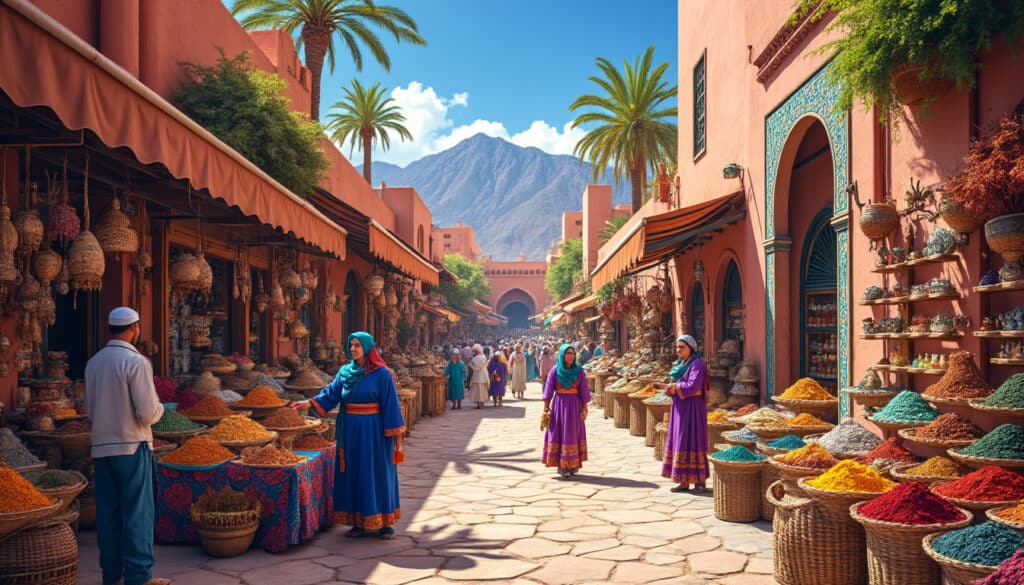
Nestled in the shadow of the magnificent Atlas Mountains, Marrakesh offers a vibrant tapestry of life that weaves together history, culture, and a thriving modern scene. Its bustling streets, scented with the aroma of spices and the buzz of local…
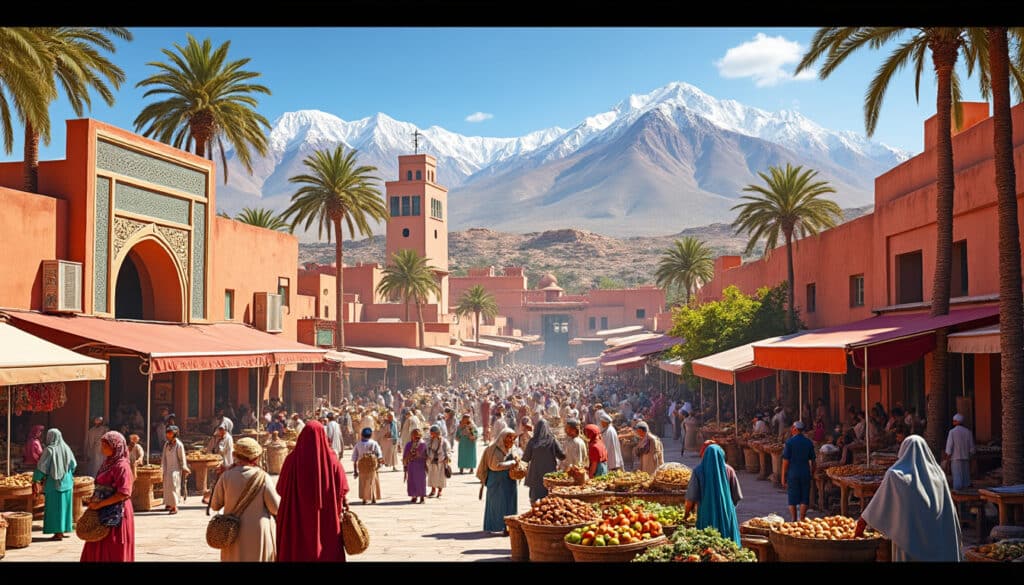
Demographics and geography of Marrakesh
Marrakesh is one of the most vibrant cities in Morocco, a hub of culture, history, and geographical diversity. Located at the foothills of the Atlas Mountains, this city boasts a unique blend of traditional and modern influences that reflect in…

Holidays and celebrations in Marrakesh
Immerse yourself in the vibrant tapestry of Marrakesh, a city brimming with an extraordinary array of holidays and celebrations. From the bustling souks to historic landmarks like the Koutoubia Mosque and the enchanting Majorelle Garden, Marrakesh offers a captivating backdrop…
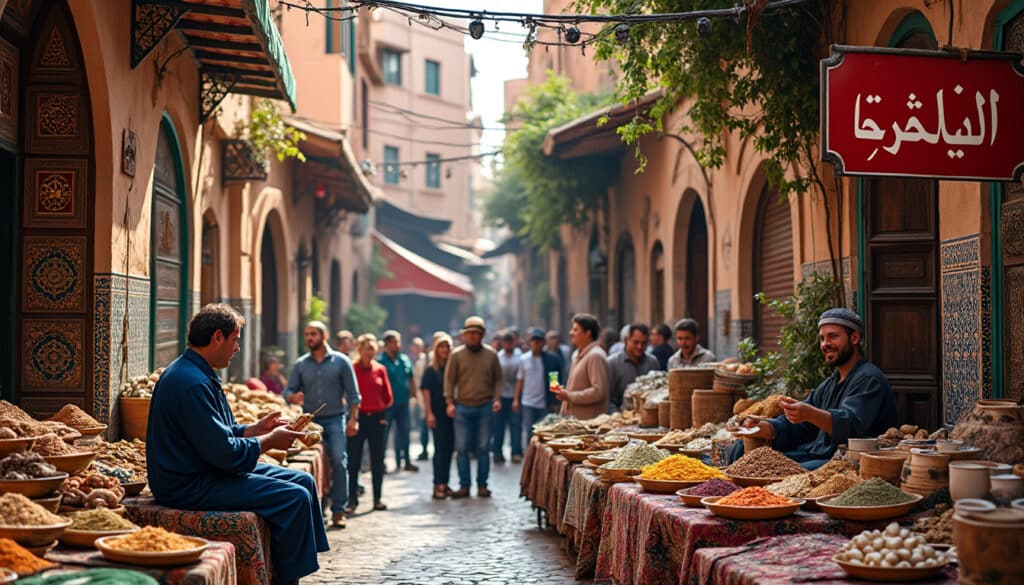
Language and spelling of Marrakesh
The city of Marrakesh, often also spelled as Marrakech, is more than just a destination known for its vibrant souks and stunning palaces. It’s a melting pot of cultures, languages, and history that reflect the dynamic interplay of evolution and…
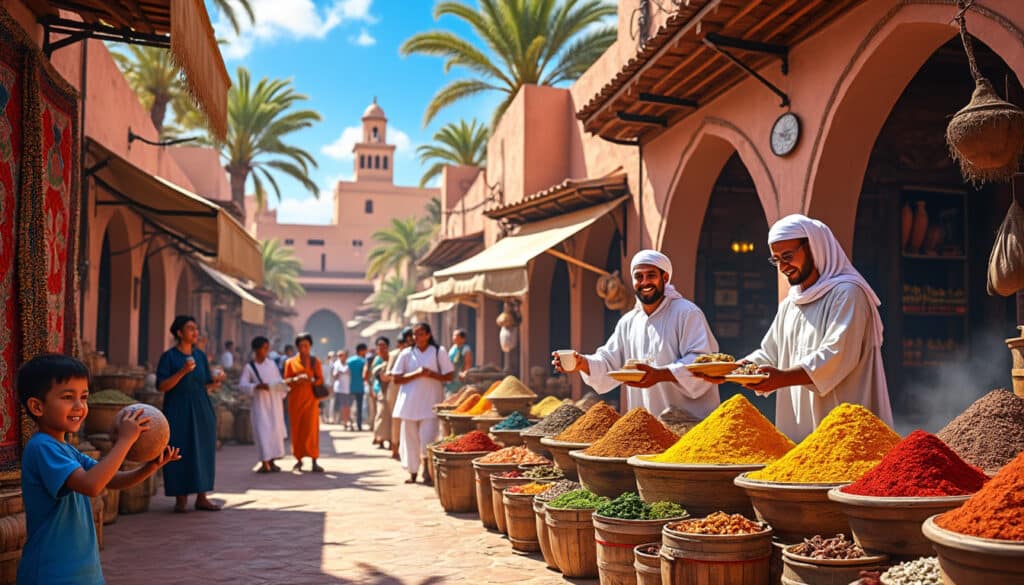
Local tips for tourists in Marrakesh
Marrakech, the captivating heart of Morocco, enchants visitors with its vibrant souks, stunning palaces, and aromatic cuisine. Known as the “Red City” due to its distinctive ocher walls, Marrakech offers a whirlwind of sensory delights that can both overwhelm and…
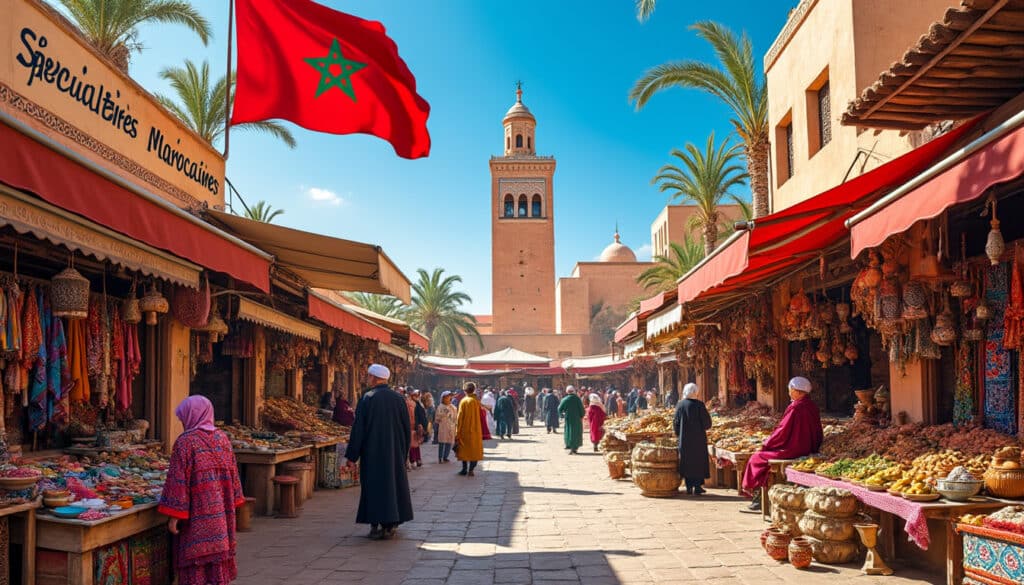
Names, flags, and identity of Marrakesh
Marrakesh, a city steeped in history and vibrant culture, is a tapestry of visual and symbolic elements that resonate with both locals and visitors alike. Known as the “Red City,” Marrakesh is an enchanting fusion of ancient traditions and modern…
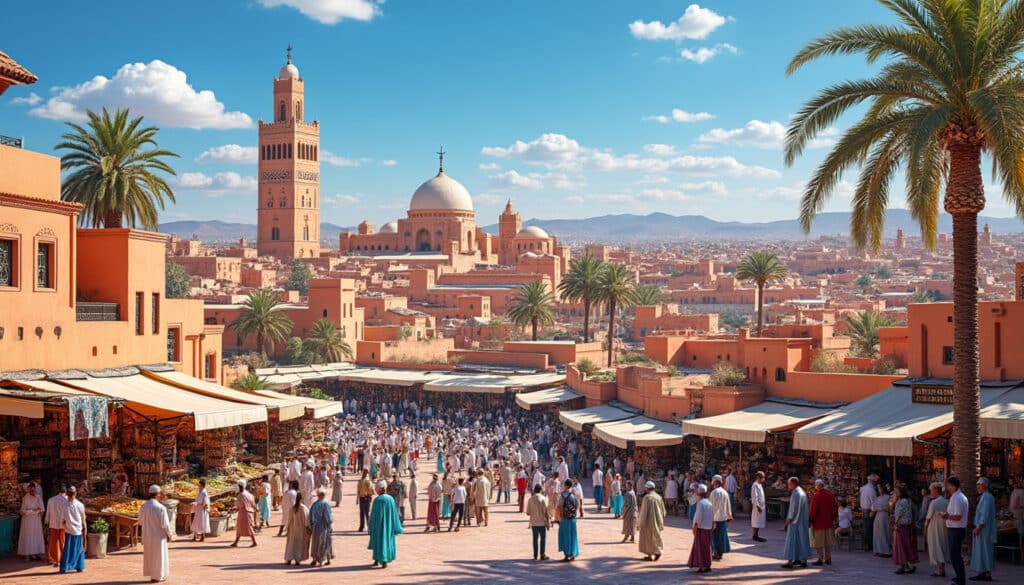
Reputation and identity of Marrakesh
Marrakesh, the “Red City” of Morocco, is a symphony of history, culture, and sensory experiences, where ancient traditions and modern lifestyles coexist beautifully. The city, with its vibrant marketplaces and iconic landmarks, offers a fascinating insight into Moroccan life. Each…
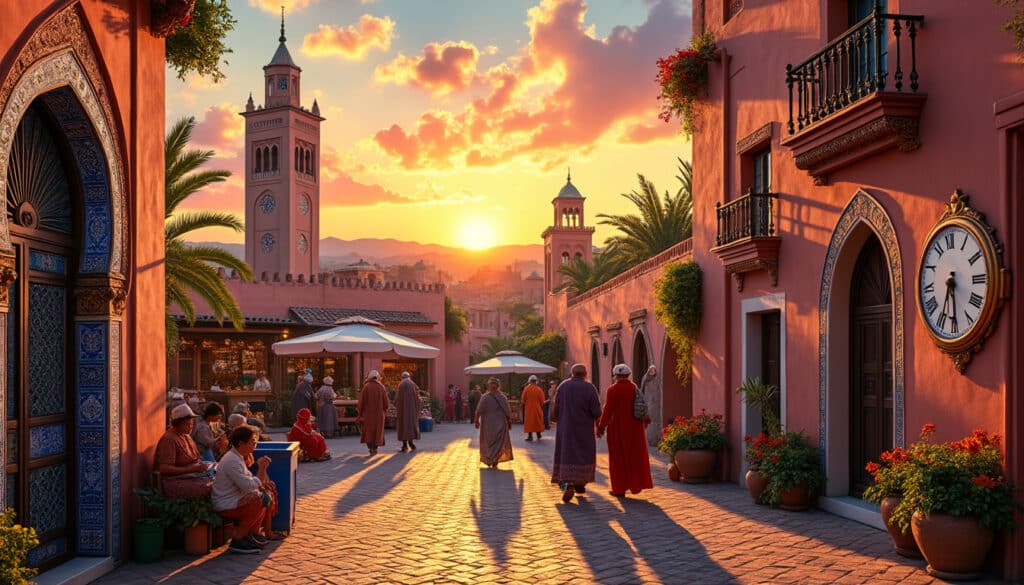
Time and time zone in Marrakesh
Marrakesh, a vibrant blend of history and culture, is a destination that attracts countless travelers every year. Whether you’re planning to experience the labyrinthine souks or explore its majestic palaces, understanding Marrakesh’s local time and timezone is essential for making…

Unusual facts and social issues in Marrakesh
Marrakesh, the captivating “Red City” of Morocco, is not only renowned for its vibrant souks and stunning architecture, but also for its unique blend of cultural and social dynamics that make it a hub of intrigue and diversity. Known for…

What does Marrakesh look, smell, feel like?
Known as the “Red City,” Marrakesh captivates all who visit with its sensory tapestry, created by the intertwining of sights, sounds, smells, flavors, and textures. A city known for its vivid colors, historical richness, and cultural diversity, Marrakesh draws explorers,…


